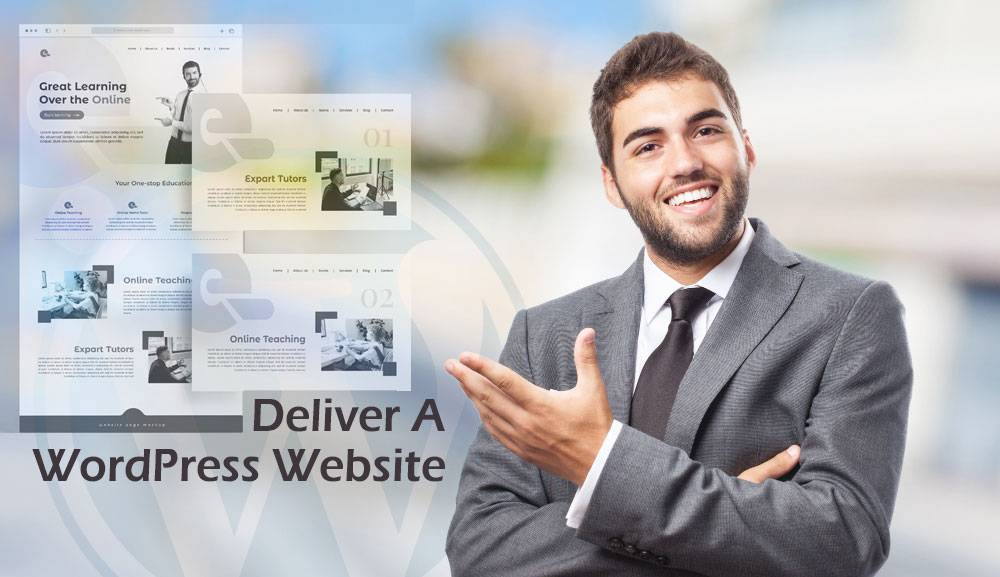How To Deliver WordPress Website To Client?

It is the result of weeks, if not months, of hard work, creativity, and collaboration with the client. However, keep in mind that the delivery process is not the end of the project, but rather the beginning of a new phase. During this stage, the client will take over the website and become responsible for its upkeep, updates, and expansion. As a result, it’s critical to prepare the website for delivery in a way that empowers the client and positions them for success. We’ll share some tips and best practices for delivering a WordPress website to a client in this blog post, including the final steps before delivery, preparing the website for delivery, the training and handover process, and post-launch optimization and maintenance. This blog post will help you ensure that your clients receive their WordPress website with confidence and enthusiasm, whether you’re a freelance developer, a digital agency, or a web designer.
Final Steps Before Delivery
Completing the development process
It is critical to ensure that the development process is complete before delivering a WordPress website to a client. This means that all of the necessary features, functionalities, and customizations have been implemented in accordance with the client’s requirements. It’s also critical to make sure the website is fully responsive, works well on various devices, and loads quickly.
Testing the website for errors
When the development process is finished, the website should be tested for errors. This includes looking for broken links, missing images, 404 errors, and any other issues that may affect the usability or functionality of the website. It is critical to thoroughly test the website, both from the client’s and the end user’s perspectives.
Optimization and Performance testing
It is critical to optimize the website’s performance in addition to testing for errors. This includes improving the speed, page load times, and overall user experience of the website. It is critical to ensure that the website works well on various devices and platforms and that it is search engine optimized.
SEO audit and optimization
SEO (search engine optimization) is an essential component of any WordPress website. Prior to delivering the website to the client, an SEO audit should be performed to identify any issues that may affect the website’s visibility and rankings on search engines. This includes optimizing the content, meta tags, images, and other SEO-related elements on the website.
Preparing the Website for Delivery
Backup and Security measures
Before delivering the website to the client, make sure it’s backed up and secure. This includes making a backup of the website’s files and database, as well as putting in place security measures like SSL encryption, firewalls, and strong passwords. This safeguards the website against cyber threats and data loss.
Site Documentation and Guides
In addition to backup and security measures, it is critical to prepare documentation and client guides. This includes user manuals, guides on how to use various features and functionalities of the website, and other resources that assist the client in effectively managing the website.
Necessary legal and regulatory compliance
Legal and regulatory compliance requirements may apply depending on the type of website and the client’s industry. It is critical to ensure that the website complies with all applicable laws and regulations, such as GDPR, ADA, and CCPA.
Organizing access credentials and other logins
Finally, it is critical to organize the client’s access credentials and other logins. This includes giving the client access to the website’s hosting account, content management system (CMS), and other tools needed to manage the website. It is critical to ensure that the client has all of the information needed to access and manage the website effectively.
Training and Handover Process
The importance of training and handover
After delivering the website to the client, it is critical to provide them with the necessary training and support to effectively manage the website. This includes ensuring that the client understands how to use the features and functionalities of the website, as well as how to manage its content and settings.
Creating User Manuals and video tutorials
Creating user manuals and video tutorials is one of the best ways to provide training and support to clients. These resources should be simple to understand and provide step-by-step instructions on how to use various website features. Providing these resources can assist the client in quickly and effectively catching up.
Preparing the client to take over the website
Along with training and support, it is critical to prepare the client to take over the website. This includes giving them access to the necessary tools and resources, as well as making sure they understand their responsibilities and obligations as website owners.
Providing long-term support
Finally, it is critical to provide the client with long-term support. This includes answering any questions they may have, offering technical assistance as needed, and ensuring that the website continues to function properly over time.
Post-Launch Optimization and Maintenance
Importance of Post-Launch maintenance
It is critical to continue optimizing and maintaining the website after it is delivered to the client. This includes monitoring the website’s performance, resolving any problems that arise, and keeping it up to date with the most recent software and security updates.
Monitoring the website traffic and analytics
Monitoring the website’s traffic and analytics is one of the most important aspects of post-launch maintenance. Tracking the number of visitors, where they come from, how long they stay on the website, and other metrics that provide insight into the website’s performance are all part of this. This data can be used to identify areas for improvement and to guide future optimizations.
Regular Software updates
To ensure the website’s continued performance and security, keep it up to date with the latest software updates. This includes updates to the CMS, plugins, and other tools used by the website. Regular updates can help ensure that the website remains secure, fast, and functional.
Backup and Security measures
Finally, it is critical to maintaining backup and security measures to keep the website safe from cyber threats and data loss. This includes performing regular backups of the website’s files and database, as well as putting in place security measures like SSL encryption, firewalls, and strong passwords. These safeguards can help safeguard the website and its data over time.
Conclusion:
Finally, delivering a WordPress website to a client necessitates meticulous planning, execution, and ongoing maintenance. You can ensure that the website is ready for delivery by completing the development process, testing it for errors, optimizing its performance, and conducting an SEO audit. Once the website is complete, it is critical to prepare the client for its handover by creating user manuals and video tutorials, as well as providing ongoing support. Finally, post-launch optimization and maintenance, such as regular updates, security measures, and backups, can help ensure the website’s functionality and security over time. You can deliver a WordPress website to a client that is not only functional and effective but also meets their specific needs and requirements by following these steps.


